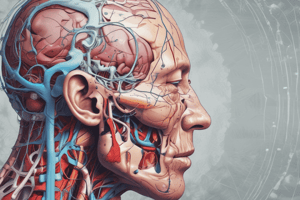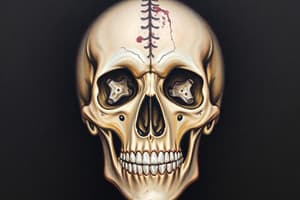Podcast
Questions and Answers
Which type of hematoma is characterized by arterial bleeding between the dura mater and the skull?
Which type of hematoma is characterized by arterial bleeding between the dura mater and the skull?
- Epidural hematoma (correct)
- Contusion
- Intracerebral hemorrhage
- Subdural hematoma
Subdural hematomas typically occur due to arterial bleeding.
Subdural hematomas typically occur due to arterial bleeding.
False (B)
List two signs of increased intracranial pressure (ICP).
List two signs of increased intracranial pressure (ICP).
Decreased level of consciousness and pupillary dilation
A _____ can occur from lesions within the tissue of the brain itself.
A _____ can occur from lesions within the tissue of the brain itself.
Match the type of injury with its description:
Match the type of injury with its description:
Which intervention helps prevent complications in a patient with increased ICP?
Which intervention helps prevent complications in a patient with increased ICP?
All brain tumors are malignant.
All brain tumors are malignant.
What symptom may suggest difficulties with coordination related to a brain tumor?
What symptom may suggest difficulties with coordination related to a brain tumor?
Which type of seizure involves a brief loss of consciousness and staring off into space?
Which type of seizure involves a brief loss of consciousness and staring off into space?
The postictal period occurs immediately before a seizure.
The postictal period occurs immediately before a seizure.
What is the medical emergency called that involves continuous or repeated seizures lasting for 30 minutes or more?
What is the medical emergency called that involves continuous or repeated seizures lasting for 30 minutes or more?
The ______ type of seizure is characterized by a sudden loss of muscle tone that causes a patient to collapse.
The ______ type of seizure is characterized by a sudden loss of muscle tone that causes a patient to collapse.
Match the following types of head injuries with their descriptions:
Match the following types of head injuries with their descriptions:
What is a common side effect of the anticonvulsant drug Phenytoin (Dilantin)?
What is a common side effect of the anticonvulsant drug Phenytoin (Dilantin)?
What should be done for a patient during a seizure to ensure their safety?
What should be done for a patient during a seizure to ensure their safety?
Patients can safely have objects placed in their mouth during a seizure to prevent biting their tongue.
Patients can safely have objects placed in their mouth during a seizure to prevent biting their tongue.
What is the drug of choice for decreasing cerebral edema and lowering intracranial pressure?
What is the drug of choice for decreasing cerebral edema and lowering intracranial pressure?
A simple partial seizure impairs consciousness.
A simple partial seizure impairs consciousness.
Name one potential trigger for a migraine headache.
Name one potential trigger for a migraine headache.
Tension headaches result from prolonged muscle contraction due to ___ or stress.
Tension headaches result from prolonged muscle contraction due to ___ or stress.
Match each type of seizure with its description:
Match each type of seizure with its description:
Which treatment is commonly used for cluster headaches?
Which treatment is commonly used for cluster headaches?
Severe migraines can be treated with Sumatriptan.
Severe migraines can be treated with Sumatriptan.
What is a common symptom of a tension headache?
What is a common symptom of a tension headache?
Hyperventilation can help ___ and assist in decreasing intracranial pressure.
Hyperventilation can help ___ and assist in decreasing intracranial pressure.
What is one of the possible causes of seizure disorders?
What is one of the possible causes of seizure disorders?
Flashcards are hidden until you start studying
Study Notes
Neurological Injuries and Conditions
- Loss of consciousness, headache, amnesia, nausea, and vomiting are common symptoms of brain injury.
- Contusion involves bruising and bleeding in brain tissue, which can lead to serious complications.
Hematomas
- Subdural Hematoma: Involves venous bleeding under the dura mater.
- Epidural Hematoma: Arterial bleeding between the dura mater and skull; patients typically have a momentary loss of consciousness, regain alertness, and then rapidly deteriorate.
- Monitor for signs of increased intracranial pressure (ICP) after head injuries, including drowsiness and pupillary dilation.
Types of Hemorrhage
- Intracerebral Hemorrhage: Bleeding occurs from lesions within the brain tissue.
- Penetrating Injuries: Sharp objects penetrate the skull and brain.
Increased Intracranial Pressure (ICP) Management
- Symptoms of increased ICP include decreased level of consciousness, agitation, increased systolic blood pressure, and bradycardia.
- Interventions include elevating the head of the bed 30 degrees, avoiding suctioning, administering diuretics or anti-inflammatories, and monitoring for respiratory depression.
Brain Tumors
- Can be malignant, congenital, or hereditary, with environmental factors possibly contributing to development.
- Symptoms depend on the affected brain area and may include visual disturbances, new-onset seizures, and balance challenges.
Seizure Types and Management
- Tonic-Clonic Seizures (Grand Mal): Characterized by muscle stiffening followed by rhythmic movement and loss of consciousness.
- Absence Seizures (Petit Mal): Brief loss of consciousness; patient appears to be staring.
- Myoclonic Seizures: Brief jerking movements of extremities.
- Atonic Seizures (Drop Attacks): Sudden loss of muscle tone.
- Status Epilepticus: Continuous seizures lasting 30 minutes or more, requiring immediate medical intervention.
Pharmacologic Treatment
- Anticonvulsants: Aim to reduce neuron hyperexcitability. Common medications include Phenytoin (Dilantin) and Pregabalin (Lyrica).
- Side effects of Phenytoin include gingival hyperplasia and drowsiness; must be monitored closely.
- Seizure precautions include ensuring patient safety, maintaining low bed positions, and padding side rails.
Head Injury Overview
- Common injuries include lacerations, contusions, abrasions, and hematomas.
- A concussion is defined as trauma without visible skull or brain injury.
Migraine Headaches
- Triggered by factors such as hormonal changes, alcohol, stress, and certain foods.
- Symptoms include unilateral pain, nausea, vomiting, and sensitivity to light and sound.
- Treatments vary from over-the-counter analgesics for mild cases to ergotamines and triptans for severe migraines.
Cluster and Tension Headaches
- Cluster Headaches: Occur in a series, intensely painful, often stress-related, without warning symptoms. Treatment may involve cold applications and Indomethacin.
- Tension Headaches: Caused by prolonged muscle contraction due to stress or other factors, with symptoms of nausea and dizziness. Management includes psychotherapy and non-opioid analgesics.
Seizure Disorder Etiology
- Can result from physical trauma, infections, electrolyte disturbances, and tumors, leading to chaotic electrical impulses in the brain.
- Partial Seizures: Include simple (no loss of consciousness) and complex (impaired consciousness) types, with various motor and sensory symptoms.
Key Nursing Interventions
- Ensure patient safety during seizures by not restraining them, turning them sideways, and keeping the environment free of hazards.
- Document seizures carefully to monitor patterns and provide appropriate interventions.
Studying That Suits You
Use AI to generate personalized quizzes and flashcards to suit your learning preferences.




